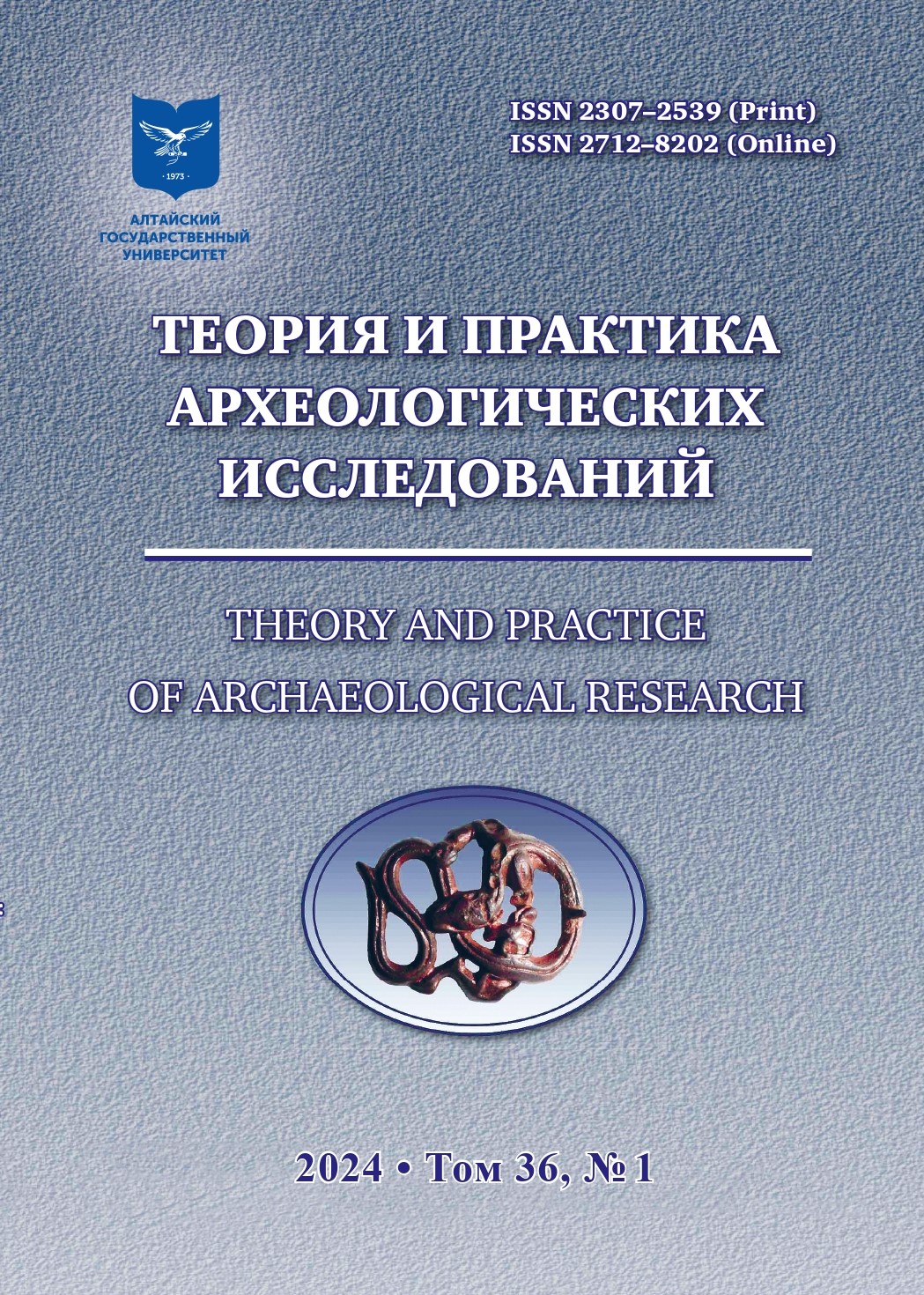SMALL FORMS TOREUTICS OF THE LATE MIDDLE AGES PERIOD FROM THE MINUSINSK MUSEUM COLLECTION
Abstract
The article presents the results of a study of a group of 29 small-form iron toreutics objects found in the funds of the Minusinsk Martyanov Museum. The items include: 22 belt tips with geometric compositions of triangles, three belt distributors with geometric ornaments, one movable buckle and three overlays with geometric and floral ornaments.
Most of the items are covered with light-colored metal. It was found that it was silver obtained from native silver, sulfosols and other ores. An assumption has been made about the origin of a part of the metal from the territory of Tuva.
Based on the experimental tracological analysis, the manufacturing technology of the products was reconstructed. The conclusion is made about the use of two silver fastening techniques. The first one was used for the ornamentation of belt tips and was an intermediate option between the inlay of large areas and the “notch” application. The second technique is found on other subjects. It was a “notch” on iron, that common among the Siberian peoples, described by ethnographers and travelers.
The belt tips are dated to the period of the 14th–15th — 17th–18th centuries, the rest of the products had broader dates from the middle of the 2nd millennium AD up to the ethnographic modernity.
The products vividly demonstrate the process of transformation during the Late Middle Ages of the tradition of making small-shaped iron torques, common in the Askiz culture of the 10th–14th centuries.
The change in tradition is associated with the introduction of a new technique for fixing metal with thermal effects in Southern Siberia.
Downloads
Metrics
No metrics found.
References
Bobrov L.A., Hudyakov Yu.S. Armament and Tactics of the Nomads of Central Asia and Southern Siberia during the Late Medieval and Early Modern Ages (the 15th — the first half of the 18th centuries A.D.). St. Petersburg : Filologicheskij fakul’tet SPbGU, 2008. 776 p. (In Russ.)
Borodovskij A.P., Obolenskij A.A., Babich V.V., Borisenko A.S., Morcev N.K. Ancient Silver of Siberia (brief history, metal composition, ore deposits). Novosibirsk : Izd-vo IAET SO RAN, 2005. 88 p. (In Russ.)
Butanaev V.Ya. The Socio-Economic History of Khongorai (Khakassia) in the 19th — early 20th Century. Abakan : Izd-vo HGU im. N.F. Katanova, 2002. 212 p. (In Russ.)
Butanaev V.Ya. The Silver Art in the Culture of the Kyrgyz People of Yenisey. In: Modern Ethnic Processes in the Central Asia: Challenges and Prospects. Kyzyl : Izd-vo TuvGU, 2019. Pp. 26–31. (In Russ.)
Weinstein S.I. The History of Folk Art of Tuva. Moskow : Nauka, 1974. 224 p. (In Russ.)
Georgi I.G. Description of All the Peoples Living in the Russian State. Their Everyday Rituals, Customs, Clothes, Dwellings, Exercises, Amusements, Creeds and Other Memorabilia. Part Four is about the Mongolian Peoples, about Armenians, Georgians, Indians, Germans, Poles and the Ruling Russians, with a Description of All the Names of the Cossacks, as Well as the Story of Little Russia and Especially about Kurland and Lithuania. St. Petersburg : Imperatorskaya Akademiya Nauk, 1799. 446 p. (In Russ.)
Girya E.Yu. Technological Analysis of Stone Industries (methodology of micro-macroanalysis of ancient tools, part 2). St. Petersburg : Akadem Print, 1997. 198 p. (In Russ.)
State Report on the State and Use of Mineral Resources of the Russian Federation in 2021. Moscow : FGBU VIMS, 2022. 622 p. (In Russ.)
Grach A.D. Results and Prospects of Archaeological Research in Tuva. In: Brief Reports on Reports and Field Studies of the Institute of Archaeology. Vol. 118. Moscow : Nauka, 1969. Pp. 43–57. (In Russ.)
Grach A.D., Savinov D.G., Dluzhnevskaya G.V. Yenisei Kyrgyz in the Center of Tuva. Moscow: Fundamenta-Press, 1998. 85 p. (In Russ.)
Davydov R.V. The stages of Formation of the Technology of Production of Iron Objects of the Toreutics of the Yenisei Kyrgyz (based on the materials of the monuments of the valley of the Us River). In: Actual Archaeology 5. St. Petersburg : Nevskaya Tipografiya, 2020. Pp. 317–319. (In Russ.)
Davydov R.V. Inlaid Toreutics of the Yenisei Kyrgyz: a Technological Aspect. In: Proceedings of the LXI Russian (with international participation) Archaeological and Ethnographic Conference of Students and Young Scientists, Irkutsk, April 04–08, 2021. Irkutsk : Irkutskij gosudarstvennyj universitet, 2021. Pp. 171–172. (In Russ.)
Dluzhnevskaya G.V. On the Change of Appearance of Metal Products in the Culture of the Yenisei Kirghiz in the 10th–11th Centuries. In: Changes in Cultures and Migrations in Western Siberia. Tomsk : Izd- vo TGU, 1987. Pp. 100–103. (In Russ.)
Ancient Cultures of the Bertek Valley (Gorny Altai, Ukok plateau) / Edited by V.I. Molodin. Novosibirsk : Nauka, 1994. 224 p. (In Russ.)
History of Siberia.: in 4 volumes. Volum 2.: Iron Age and Medievak Period / Edited by V.I. Molodin. Novosibirsk : Izd-vo IAET SO RAN, 2019. 643 p. (In Russ.)
Kyzlasov I.L. Askiz Culture of Southern Siberia. Moscow : Nauka, 1983a. 128 p. (Archaeology of the USSR. A set of archaeological sources. E3-18). (In Russ.)
Kyzlasov I.L. On the History of Metalworking in Southern Siberia. The Notch on the Iron. In: Medieval Urban Culture of Kazakhstan and Central Asia. Alma-Ata : Nauka, 1983b. Pp. 120–130. (In Russ.)
Minasyan R.S. Metalworking in Antiquity and the Middle Ages. St. Petersburg : Izd-vo Gos. Ermitazha, 2014. 472 p. (In Russ.)
Mitko O.A., Polovnikov I.S., Skobelev S.G. Saber from the Neighborhood Novaya Syda in the Krasnoturansky District of the Krasnoyarsky Krai. In: Vulture of Russians in Archaeological Research: Archaeology of the North of Russia. Vol. 2. Omsk : Izdatel’skaya gruppa ANO «Institut arheologii Severa», 2021. Pp. 155–158. (In Russ.)
Patachakov K.M. Culture and Life of the Khakass in the Light of Historical Ties with the Russian People (the 18th–19th Centuries). Abakan : Hakasskoe knizhnoe izdatel’stvo, 1958. 104 p. (In Russ.)
Rudenko K.A. Iron Products with Inlay from Volga Bulgaria of the 11th–17th Centuries. In: Penza Archaeological Collection. Issue 5. Penza : Institut regional’nogo razvitiya Penzenskoj oblasti, 2022. Pp. 203–225. (In Russ.)
Savinov D.G. Archaeological Sites of the Final Stage of the Culture of the Yenisei Kyrgyz. In: Sites of Kyrgyz Culture in North and Central Asia. Novosibirsk : Institut istorii i filologii, 1990. Pp. 114–131. (In Russ.)
Silver ponds. Methodological Recommendations on the Application of Reserve Classification to Silver Ore Deposits. Moscow : FGU GKZ, 2007. 44 p. (In Russ.)
Skobelev S.G. Late Medieval Archaeology and the Problem of Ethnogenesis of Modern Indigenous Peoples of Southern Siberia. In: Problems of Medieval Archaeology of SouthernSiberia and Adjacent Territories. Novosibirsk : Izd-vo NGU, 1991. Pp. 138–158. (In Russ.)
Skobelev S.G. Late Medieval Archaeological Sites of the South of Central Siberia: Problems and Results of the Study. In: Russian Archaeology: Achievements of the 20th and Prospects of the 21st Century. Izhevsk : Udmurtskij universitet, 2000. Pp. 166–169. (In Russ.)
Flerov A.V. Materials Science and Technology of Artistic Metalworking. Moscow : Vysshaya shkola, 1981. 288 p. (In Russ.)
Khudyakov Yu.S., Skobelev S.G. Late Medieval Shamanic Burial in the Burial Ground of Ortyzy-Oba. In: Ethnography of the Peoples of Siberia. Novosibirsk : Nauka, 1984. Pp. 105–120. (In Russ.)
Dolfini A., Crellin R.J. Metalwork Wear Analysis: The Loss of Innocence. Journal of Archaeological Science. 2016;66:78–87.
Copyright (c) 2024 Р.В. Давыдов, М.Д. Ганш, Е.О. Ганш, Д.А. Шаманин

This work is licensed under a Creative Commons Attribution 4.0 International License.
Theory and Practice of Archaeological Research is a golden publisher, as we allow self-archiving, but most importantly we are fully transparent about your rights.
Authors may present and discuss their findings ahead of publication: at biological or scientific conferences, on preprint servers, in public databases, and in blogs, wikis, tweets, and other informal communication channels.
Theory and Practice of Archaeological Research allows authors to deposit manuscripts (currently under review or those for intended submission to ABS) in non-commercial, pre-print servers such as ArXiv.
Authors who publish with this journal agree to the following terms:
- Authors retain copyright and grant the journal right of first publication with the work simultaneously licensed under a Creative Commons Attribution License (CC BY 4.0) that allows others to share the work with an acknowledgement of the work's authorship and initial publication in this journal.
- Authors are able to enter into separate, additional contractual arrangements for the non-exclusive distribution of the journal's published version of the work (e.g., post it to an institutional repository or publish it in a book), with an acknowledgement of its initial publication in this journal.
- Authors are permitted and encouraged to post their work online (e.g., in institutional repositories or on their website) prior to and during the submission process, as it can lead to productive exchanges, as well as earlier and greater citation of published work (See The Effect of Open Access).








2.jpg)




